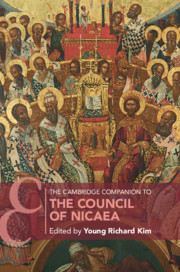Refine search
Actions for selected content:
23990 results in Ancient history
Contents
-
- Book:
- The Cambridge Companion to the Council of Nicaea
- Published online:
- 17 December 2020
- Print publication:
- 07 January 2021, pp ix-x
-
- Chapter
- Export citation
9 - The Council of Nicaea and the Celebration of the Christian Pasch
- from Part III - Outcomes
-
-
- Book:
- The Cambridge Companion to the Council of Nicaea
- Published online:
- 17 December 2020
- Print publication:
- 07 January 2021, pp 177-201
-
- Chapter
- Export citation
Bibliography
-
- Book:
- The Cambridge Companion to the Council of Nicaea
- Published online:
- 17 December 2020
- Print publication:
- 07 January 2021, pp 378-415
-
- Chapter
- Export citation
Appendix 2: - Letter of the Synod of Nicaea to the Egyptians
- from Appendices
-
- Book:
- The Cambridge Companion to the Council of Nicaea
- Published online:
- 17 December 2020
- Print publication:
- 07 January 2021, pp 376-377
-
- Chapter
- Export citation
11 - The Reception of Nicaea and Homoousios to 360
- from Part IV - The Aftermath
-
-
- Book:
- The Cambridge Companion to the Council of Nicaea
- Published online:
- 17 December 2020
- Print publication:
- 07 January 2021, pp 225-255
-
- Chapter
- Export citation
Acknowledgements
-
- Book:
- The Cambridge Companion to the Council of Nicaea
- Published online:
- 17 December 2020
- Print publication:
- 07 January 2021, pp xiv-xv
-
- Chapter
- Export citation
12 - The Emergence of the Pro-Nicene Alliance
- from Part IV - The Aftermath
-
-
- Book:
- The Cambridge Companion to the Council of Nicaea
- Published online:
- 17 December 2020
- Print publication:
- 07 January 2021, pp 256-281
-
- Chapter
- Export citation
Copyright page
-
- Book:
- The Cambridge Companion to the Council of Nicaea
- Published online:
- 17 December 2020
- Print publication:
- 07 January 2021, pp vi-vi
-
- Chapter
- Export citation
7 - The Creed
- from Part III - Outcomes
-
-
- Book:
- The Cambridge Companion to the Council of Nicaea
- Published online:
- 17 December 2020
- Print publication:
- 07 January 2021, pp 135-157
-
- Chapter
- Export citation
Appendices
-
- Book:
- The Cambridge Companion to the Council of Nicaea
- Published online:
- 17 December 2020
- Print publication:
- 07 January 2021, pp 368-377
-
- Chapter
- Export citation
Dedication
-
- Book:
- The Cambridge Companion to the Council of Nicaea
- Published online:
- 17 December 2020
- Print publication:
- 07 January 2021, pp vii-viii
-
- Chapter
- Export citation
14 - The Council of Ariminum (359) and the Rise of the Neo-Nicenes
- from Part IV - The Aftermath
-
-
- Book:
- The Cambridge Companion to the Council of Nicaea
- Published online:
- 17 December 2020
- Print publication:
- 07 January 2021, pp 305-324
-
- Chapter
- Export citation
4 - Hosting the Council in Nicaea
- from Part II - The Council
-
-
- Book:
- The Cambridge Companion to the Council of Nicaea
- Published online:
- 17 December 2020
- Print publication:
- 07 January 2021, pp 65-89
-
- Chapter
- Export citation
Part III - Outcomes
-
- Book:
- The Cambridge Companion to the Council of Nicaea
- Published online:
- 17 December 2020
- Print publication:
- 07 January 2021, pp 133-222
-
- Chapter
- Export citation
5 - Reconstructing the Council of Nicaea
- from Part II - The Council
-
-
- Book:
- The Cambridge Companion to the Council of Nicaea
- Published online:
- 17 December 2020
- Print publication:
- 07 January 2021, pp 90-110
-
- Chapter
- Export citation
Figures
-
- Book:
- The Cambridge Companion to the Council of Nicaea
- Published online:
- 17 December 2020
- Print publication:
- 07 January 2021, pp xi-xi
-
- Chapter
- Export citation
2 - Imperial Fathers and Their Sons
- from Part I - Contexts
-
-
- Book:
- The Cambridge Companion to the Council of Nicaea
- Published online:
- 17 December 2020
- Print publication:
- 07 January 2021, pp 19-42
-
- Chapter
- Export citation

The Cambridge Companion to the Council of Nicaea
-
- Published online:
- 17 December 2020
- Print publication:
- 07 January 2021
Appendix O - Etruscan Amphorae from Latium
-
- Book:
- The Origins of the Roman Economy
- Published online:
- 18 February 2021
- Print publication:
- 17 December 2020, pp 287-290
-
- Chapter
- Export citation
Five - Competition and Emulation
-
- Book:
- The Amorites and the Bronze Age Near East
- Published online:
- 23 January 2021
- Print publication:
- 17 December 2020, pp 257-344
-
- Chapter
- Export citation
